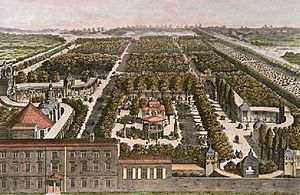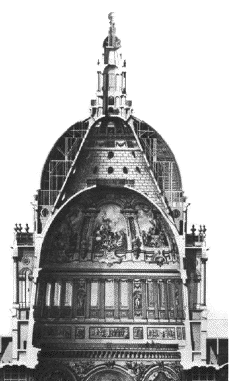Samuel Wale facts for kids
Samuel Wale RA (1721? – 1786) was a talented English artist. He was known for painting historical scenes and creating pictures for books. He was also one of the first members of the important Royal Academy of Arts.

About Samuel Wale's Life
Samuel Wale was likely born in Great Yarmouth, Norfolk, around April 25, 1721. Some records suggest he might have been born in London instead.
He first learned a skill called engraving on silver plate. This means carving designs into silver metal. Later, he studied drawing with a famous artist named Francis Hayman at the St. Martin's Lane academy.
Wale also helped an architect named John Gwynn with his building drawings. They worked together on a detailed drawing of St Paul's Cathedral. This drawing showed the inside of the cathedral and was published in 1752.
In 1765, Samuel Wale became one of the first members of the Society of Artists of Great Britain. Then, in 1768, he became a founding member of the Royal Academy. He was the very first professor of perspective at the Academy. This meant he taught artists how to draw things so they look like they have depth and distance.
From 1769 to 1778, he showed his drawings of English history scenes. He also exhibited some religious subjects, which were designs for church altars. In 1778, he had a paralytic stroke, which affected his movement. Because of this, he was the first member to receive money from the Royal Academy's pension fund.
Even though he was ill, he kept his job as professor of perspective. He gave lessons from his home instead of lecturing. In 1782, after Richard Wilson passed away, Wale also became the librarian for the Royal Academy. He held both jobs until he died on February 6, 1786.
Samuel Wale never married or had children. He left his copper plates, prints, and other belongings to his friend and fellow Royal Academy founder, John Gwynn. They had shared a house together. He also left things to his nurse, Mrs. Mary Gurpin. Wale was buried in St. Martin-in-the-Fields church. You can see his picture in a painting by Johann Zoffany from 1772, which shows the Royal Academy members.
Samuel Wale's Artworks
Samuel Wale created some decorative designs for ceilings. This style of art was becoming less popular at the time. He also sometimes painted signs for shops. However, a law in 1762 stopped these types of signs.
One of his most famous works was a large painting of William Shakespeare. It hung outside a tavern near Drury Lane. This painting became well-known because of its fancy frame and the ironwork that held it up. But it had to be taken down soon after it was put up.
Most of Wale's work involved designing small pictures called vignettes and illustrations for books. Many of these were carved by Charles Grignion the Elder. Some of the books he illustrated include:
- The ‘History of England’ (1746–47)
- ‘The Compleat Angler’ (1759)
- ‘London and its Environs described’ (1761)
- ‘Ethic Tales and Fables’
- William Wilkie's ‘Fables’ (1768), which had eighteen of his plates
- Henry Chamberlain's ‘History of London’ (1770)
- Oliver Goldsmith's ‘Traveller’ (1774)
His book illustrations showed the influence of his teacher, Francis Hayman.
Wale also published many pictures in the Oxford Magazine and other magazines. He showed "stained drawings" at art exhibitions from 1760 to 1767. These were designs outlined with a pen and colored with indian ink. He also showed larger drawings made with watercolors. In 1762, he designed the front cover for the exhibition catalog.


